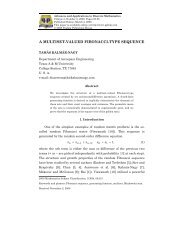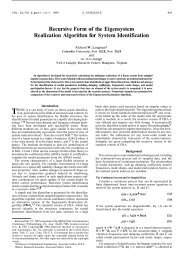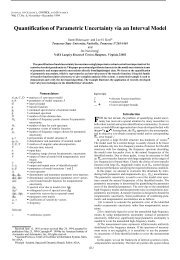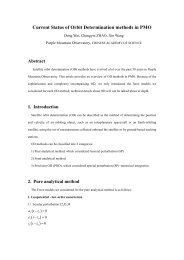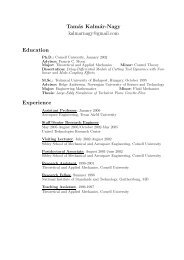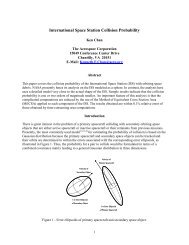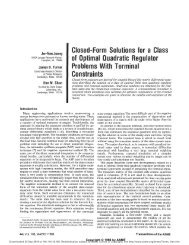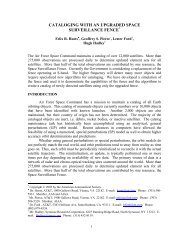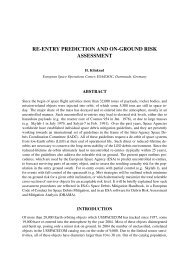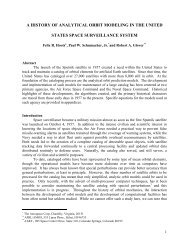Subcritical Hopf Bifurcation in the Delay Equation Model for Machine ...
Subcritical Hopf Bifurcation in the Delay Equation Model for Machine ...
Subcritical Hopf Bifurcation in the Delay Equation Model for Machine ...
You also want an ePaper? Increase the reach of your titles
YUMPU automatically turns print PDFs into web optimized ePapers that Google loves.
122 T. Kalmár-Nagy et al.Figure 1. 1 DOF mechanical model.<strong>Bifurcation</strong> Theorem and <strong>the</strong> Center Manifold Theorem. Although <strong>the</strong>se have been available<strong>for</strong> a long time [5, 7] <strong>the</strong> closed <strong>for</strong>m calculation regard<strong>in</strong>g <strong>the</strong> existence and <strong>the</strong> nature of <strong>the</strong>correspond<strong>in</strong>g <strong>Hopf</strong> bifurcation <strong>in</strong> <strong>the</strong> ma<strong>the</strong>matical model is only feasible by us<strong>in</strong>g computeralgebra (see also [2]).2. Mechanical <strong>Model</strong> <strong>for</strong> Tool VibrationsFigure 1 shows a 1 DOF mechanical model of <strong>the</strong> regenerative mach<strong>in</strong>e tool vibration <strong>in</strong> <strong>the</strong>case of <strong>the</strong> so-called orthogonal cutt<strong>in</strong>g (f denotes chip thickness). The model is <strong>the</strong> simplestone which still expla<strong>in</strong>s <strong>the</strong> basic stability problems and nonl<strong>in</strong>ear vibrations aris<strong>in</strong>g <strong>in</strong> thissystem [16–18]. The correspond<strong>in</strong>g Free Body Diagram (ignor<strong>in</strong>g horizontal <strong>for</strong>ces) is alsoshown<strong>in</strong>Figure1.Herel = l − l 0 + x(t) where l, l 0 are <strong>the</strong> <strong>in</strong>itial spr<strong>in</strong>g length and spr<strong>in</strong>glength <strong>in</strong> steady-state cutt<strong>in</strong>g, respectively. The zero value of <strong>the</strong> general coord<strong>in</strong>ate x(t) of <strong>the</strong>tool edge position is set <strong>in</strong> a way that <strong>the</strong> x component F x of <strong>the</strong> cutt<strong>in</strong>g <strong>for</strong>ce F is <strong>in</strong> balancewith <strong>the</strong> spr<strong>in</strong>g <strong>for</strong>ce when <strong>the</strong> chip thickness f is just <strong>the</strong> prescribed value f 0 (steady-statecutt<strong>in</strong>g). The equation of motion of <strong>the</strong> tool is clearlymẍ =−sl − F x − cẋ. (1)In steady-state cutt<strong>in</strong>g (x =ẋ =ẍ = 0)0 =−s(l − l 0 ) − F x (f 0 ) ⇒ F x (f 0 ) =−s(l − l 0 ),i.e., <strong>the</strong>re is pre-stress <strong>in</strong> <strong>the</strong> spr<strong>in</strong>g. If we write F x = F x (f 0 )+F x <strong>the</strong>n <strong>Equation</strong> (1) becomesẍ + 2ζω n ẋ + ω 2 n x =−1 m F x, (2)where ω n = √ s/m is <strong>the</strong> natural angular frequency of <strong>the</strong> undamped free oscillat<strong>in</strong>g system,and ζ = c/(2mω n ) is <strong>the</strong> so-called relative damp<strong>in</strong>g factor.The calculation of <strong>the</strong> cutt<strong>in</strong>g <strong>for</strong>ce variation F x requires an expression of <strong>the</strong> cutt<strong>in</strong>g<strong>for</strong>ce as a function of <strong>the</strong> technological parameters, primarily as a function of <strong>the</strong> chip thicknessf which depends on <strong>the</strong> position x of <strong>the</strong> tool edge. The traditional models [20, 21] use<strong>the</strong> cutt<strong>in</strong>g coefficient k 1 derived from <strong>the</strong> stationary idea of <strong>the</strong> cutt<strong>in</strong>g <strong>for</strong>ce as an empiricalfunction of <strong>the</strong> technological parameters like <strong>the</strong> chip width w, <strong>the</strong> chip thickness f ,and<strong>the</strong>cutt<strong>in</strong>g speed v.A simple but empirical way to calculate <strong>the</strong> cutt<strong>in</strong>g <strong>for</strong>ce is us<strong>in</strong>g a curve fitted to dataobta<strong>in</strong>ed from cutt<strong>in</strong>g tests. Shi and Tobias [15] gave a third-order polynomial <strong>for</strong> <strong>the</strong> cutt<strong>in</strong>g<strong>for</strong>ce (similar to Figure 2). The coefficient of <strong>the</strong> second-order term is negative which suggests





